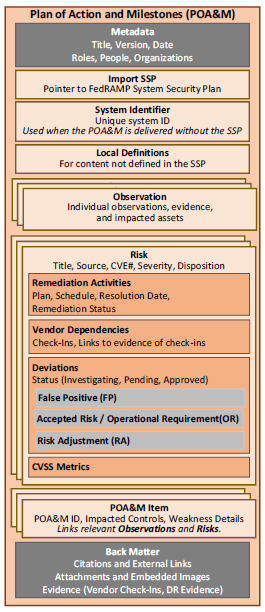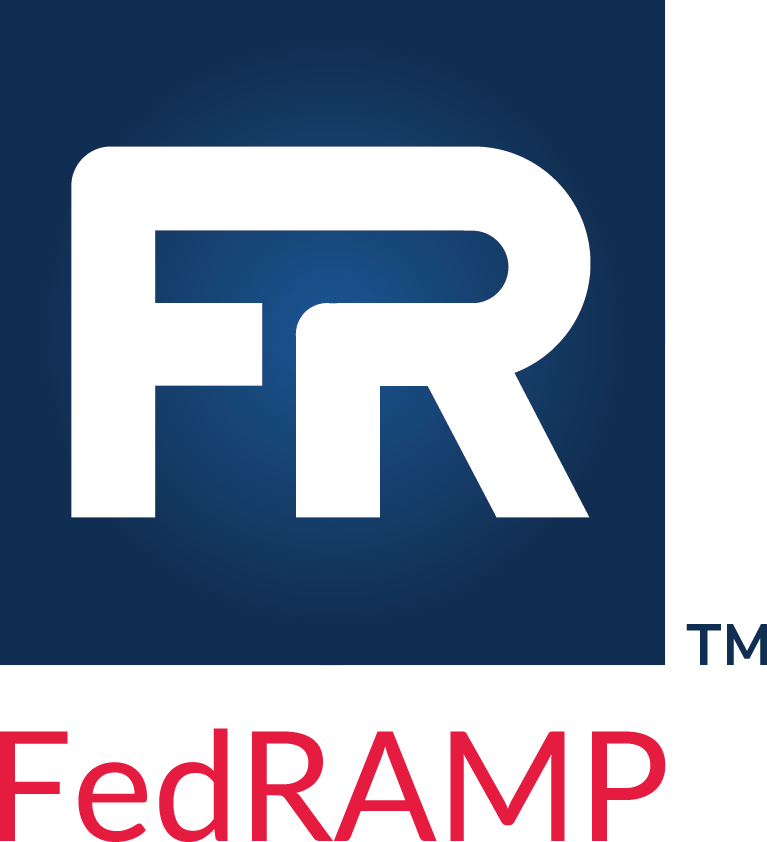FedRAMP OSCAL POA&M Overview
This section provides a summary of several important concepts and details that apply to OSCAL-based FedRAMP POA&M files.
The FedRAMP OSCAL Documentation provides important concepts necessary for working with any OSCAL-based FedRAMP file. Familiarization with those concepts is important to understanding this guide.
XML and JSON Formats
The examples provided here are in XML; however, FedRAMP accepts XML or JSON formatted OSCAL-based POA&M files. NIST offers a utility that provides lossless conversion of OSCAL-compliant files between XML and JSON in either direction.
You may submit your POA&M to FedRAMP using either format. If necessary, FedRAMP tools will convert the files for processing.
POA&M File Concepts
Unlike the traditional MS Word-and Excel based SSP and POA&M, the OSCAL-based versions of these files are designed to make information available through linkages, rather than duplicating information. In OSCAL, these linkages are established through import commands.

OSCAL file imports.
For example, the systems impacted by a vulnerability as listed in the POA&M are defined in the FedRAMP SSP and simply referenced by the POA&M.

Detailed overview of OSCAL models.
For this reason, an OSCAL-based POA&M points to the OSCAL-based SSP of the system being assessed. Instead of duplicating system details, the OSCAL-based POA&M simply points to the SSP content for information such as system description, boundary, users, locations, and inventory items.
The POA&M also inherits the SSP’s pointer to the appropriate OSCAL-based FedRAMP Baseline. Through that linkage, the POA&M references the control baseline definitions for the system’s baseline.

Resolved Profile Catalog.
For more information about resolved profile catalogs, see the Profile Resolution section.
OSCAL-based FedRAMP POA&M Template
FedRAMP offers an OSCAL-based POA&M shell file in both XML and JSON formats. This shell contains many of the FedRAMP required standards to help get you started. This documentation is intended to work in concert with that file. The OSCAL-based FedRAMP POA&M Template is available in XML and JSON formats here:
-
OSCAL-based FedRAMP POA&M Template (JSON Format):
https://github.com/GSA/fedramp-automation/raw/master/dist/content/rev5/templates/poam/json/FedRAMP-POAM-OSCAL-Template.json -
OSCAL-based FedRAMP POA&M Template (XML Format):
https://github.com/GSA/fedramp-automation/raw/master/dist/content/rev5/templates/poam/xml/FedRAMP-POAM-OSCAL-Template.xml
OSCAL’s Minimum File Requirements
Every OSCAL-based FedRAMP POA&M file must have a minimum set of required fields/assemblies, and must follow the OSCAL POA&M Model syntax found here:
https://pages.nist.gov/OSCAL/concepts/layer/assessment/poam/

Minimum File Requirements.
Importing the System Security Plan
OSCAL is designed for traceability. Because of this, the POA&M is designed to be linked to the SSP. Rather than duplicating content from the SSP, the POA&M is intended to reference the SSP content itself.
Unavailable OSCAL-based SSP Content OR Monthly Deliverable Option
OSCAL syntax requires the POA&M to import an OSCAL-based SSP, even if no OSCAL-based SSP exists.
FedRAMP recognizes that some system owners may adopt OSCAL for the POA&M before adopting it for their SSP. Similarly, FedRAMP does not currently require monthly delivery of the SSP with the monthly Continuous Monitoring POA&M delivery.
Use the import-ssp field to specify an existing OSCAL-based SSP. The href flag may include any valid uniform resource identifier (URI), including a relative path, absolute path, or URI fragment.
SSP Import Representation
|
|
XPath Queries
|
|
If the value is a URI fragment, such as #96445439-6ce1-4e22-beae-aa72cfe173d0, the value to the right of the hashtag (#) is the UUID value of a resource in the POA&M file’s back-matter. Refer to the Citations and Attachments in OSCAL Files section for guidance on handling.
POA&M Back Matter Representation
|
|
Do Not Embed the SSP in the POA&M
While OSCAL provides the ability to embed the SSP in the POA&M, this approach does not align with FedRAMP’s current delivery process and is discouraged.
XPath Queries
|
|
Where the provided path is invalid, tool developers should ensure the tool prompts the user for the updated path to the OSCAL-based SSP.
When OSCAL-based SSP Information is Inaccurate
Ideally, when SSP information is missing or inaccurate the system ISSO should correct the SSP.
If the POA&M must be updated with missing or inaccurate SSP information, the POA&M syntax allows for SSP information correction.
Tool designers should ensure their tools can cite the relevant OSCAL-based SSP information when possible, and capture assessor-corrected SSP information in the POA&M’s local-definitions or metadata sections when necessary. The relevant sections of this documentation describe how to represent inaccurate SSP information in the POA&M when needed.
Monthly Continuous Monitoring (ConMon) Delivery
For monthly ConMon deliveries, the CSP may duplicate the component and inventory-item content from their SSP into the POA&M’s local-definitions section. Delivering an OSCAL POA&M with all inventory in this way satisfies both the POA&M and System Inventory deliverables.
Delivering the POA&M and Inventory Without the SSP
FedRAMP currently requires CSPs to deliver their POA&M, system inventory, and raw scanner tool output each month. OSCAL enables the delivery of POA&M and inventory without delivering the linked SSP.
In this instance, the OSCAL allows the import-ssp syntax to be omitted; however, FedRAMP still requires the system-id content containing the system’s FedRAMP-assigned unique identifier.
All SSP inventory-item assemblies must be duplicated into the POA&M local-definitions assembly. Any SSP component cited by an inventory-item must also be duplicated to the POA&M’s local-definitions assembly.
Finally, any SSP component referenced by POA&M data must be duplicated, whether it is referenced by an inventory-item or not.
POA&M Representation
|
|
Resolution Resource Prop
FedRAMP will be implementing a separate set of automated POA&M validation rules for the rev 5 OSCAL templates. To ensure FedRAMP initiates the appropriate validation rules when processing OSCAL POA&Ms, POA&M authors should add a new prop called “resolution-resource” in the metadata section and include an associated back-matter resource as shown below:
SSP Resolution Resource
|
|
XPath Queries
|
|
If the “resolution-resource” prop is not specified in the metadata section of the POA&M, FedRAMP will assume the POA&M should be validated using the rev 5 validation rules. If the “resolution-resource” prop is present, FedRAMP will use the validation rules that correspond with the version specified in the back-matter resource.


